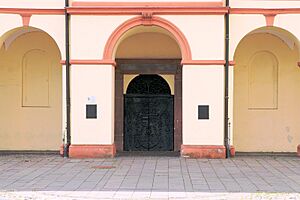George Frederick of Nassau-Siegen facts for kids
Quick facts for kids
George Frederick of Nassau-Siegen
|
|
|---|---|
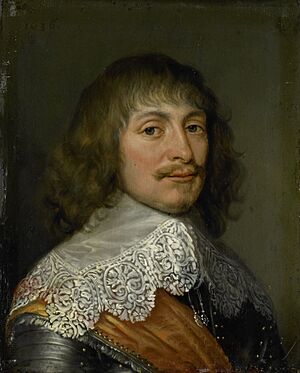
Prince George Frederick of Nassau-Siegen. Anonymous portrait, 1636. Rijksmuseum Amsterdam.
|
|
| Coat of arms | 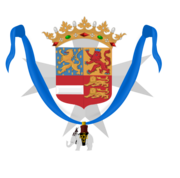 |
| Full name |
George Frederick Louis Prince of Nassau-Siegen
|
| Native name | Georg Friedrich Ludwig Prinz von Nassau-Siegen |
| Born | Georg Friedrich Ludwig Graf zu Nassau, Katzenelnbogen, Vianden und Diez, Herr zu Beilstein 23 February 1606 Dillenburg Castle |
| Died | 2 October 1674 (aged 68) Bergen op Zoom |
| Buried | Terborg, later reburied in the Fürstengruft, Siegen |
| Noble family | House of Nassau-Siegen |
| Spouse(s) | Mauritia Eleonora of Portugal |
| Father | John VII 'the Middle' of Nassau-Siegen |
| Mother | Margaret of Schleswig-Holstein-Sonderburg |
| Occupation | Captain of the infantry in the Dutch States Army 1627, ritmeester of the cavalry 1633, major 1637, colonel 1642, commander of Rheinberg 1648–1658, governor of Bergen op Zoom 1658–1674. |
Prince George Frederick of Nassau-Siegen (born 23 February 1606 – died 2 October 1674) was a count from the House of Nassau-Siegen. This family was a branch of the House of Nassau, a very old and important noble family. In 1664, George Frederick was given the special title of prince. He was also a brave officer in the Dutch States Army. He commanded the city of Rheinberg and later became the governor of Bergen op Zoom.
Contents
Life and Military Career
George Frederick was born at Dillenburg Castle on February 23, 1606. He was the second son of Count John VII 'the Middle' of Nassau-Siegen. His mother was Duchess Margaret of Schleswig-Holstein-Sonderburg. His full name was George Frederick Louis, but his family called him Fritz. In 1622, he studied in Kassel with his younger brother, William Otto.
Serving in the Dutch Army
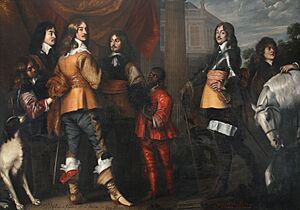
George Frederick joined the army of the United Netherlands. In 1627, he became a captain in the infantry (foot soldiers). By 1633, he was also a ritmeester (a type of captain) in the cavalry (soldiers on horseback). He quickly moved up the ranks. In 1637, he was promoted to major, and in 1642, he became a colonel.
In 1638, George Frederick and his cousin, Prince Manuel Antony of Portugal, were captured by the Spanish army. The Dutch government paid a large sum of money to get him back in 1639.
After his military service, George Frederick took on important leadership roles. In 1648, he became the commander of Rheinberg. Then, in 1658, he was appointed governor of Bergen op Zoom.
George Frederick also received special honors. In 1651, he became a Knight of the Order of the Elephant. This is a very old and important award from Denmark. In 1671, he also became a Knight of the Order of the Dannebrog, another Danish honor. On May 6, 1664, he was officially made a prince within the Holy Roman Empire.
Family Inheritance Dispute
George Frederick's father, Count John VII, made a will in 1621. In this will, he planned to divide his lands among his sons. He wanted his younger sons, including George Frederick and John Maurice, to receive parts of the county. However, his eldest son from his first marriage, John 'the Younger', was only supposed to get one-third.
John 'the Younger' was not happy with this plan. He complained to the Emperor Ferdinand II. The Emperor agreed with John 'the Younger'. He said that John VII, because he had fought against the Emperor, did not have the right to make such a will. The Emperor ordered John VII to change his will.
Count John VII died in 1623. When his will was read, John 'the Younger' presented the Emperor's order. He said, "The Emperor will part us!" This meant he expected the Emperor to decide who got what. John 'the Younger' even brought soldiers into the town of Siegen to make sure he took control.
Dividing the Lands
John 'the Younger' initially took over the entire inheritance. However, he later agreed to give some land to his half-brother William. This land included Hilchenbach and Ginsburg Castle. So, for a while, the county of Nassau-Siegen had two rulers: one in Siegen and one in Hilchenbach.
During the Thirty Years' War, things changed again. George Frederick's brothers, who were Protestants, fought against John 'the Younger', who was Catholic. In 1632, with the help of the Swedish army, John Maurice and his brother Henry took control of Siegen. They divided the lands differently, giving more to William and John Maurice. George Frederick was also meant to get a share.
However, John 'the Younger' soon regained control. By 1636, he was again the main ruler of his father's lands, except for Hilchenbach, which he left to William. John Maurice was once again left out.
The Final Agreement
John 'the Younger' died in 1638. His young son, John Francis Desideratus, then tried to claim the whole area. But in 1645, John Maurice, along with George Frederick and Henry, took control of Siegen Castle. They wanted to follow their father's original will.
To end the long family dispute, the issue was brought to the Peace of Westphalia talks in 1648. The Emperor Ferdinand III finally approved John VII's original will from 1621. This meant John Francis Desideratus received only one-third of the land, known as Johannland.
John Maurice ended up with the other two-thirds. His brother William had died and left his share to John Maurice. And in 1649, George Frederick also gave up his rights to John Maurice. So, John Maurice became the main ruler of most of the county.
Later Life and Passing
George Frederick passed away in Bergen op Zoom on October 2, 1674. He was first buried in Terborg. Later, his body was moved and reburied in the family's special burial place, the Fürstengruft, in Siegen. After his death, his relative, Count Walrad of Nassau-Usingen, took over his role as governor of Bergen op Zoom.
Marriage and Family
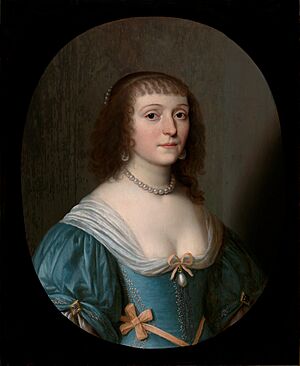
George Frederick married his cousin, Mauritia Eleonora of Portugal, on June 4, 1647, in The Hague. Mauritia Eleonora was born in Delft on May 10, 1609, and died in Bergen op Zoom on June 15, 1674. She was the daughter of Prince Manuel of Portugal and Countess Emilia of Nassau. Emilia was the youngest daughter of William I of Orange, a very famous Dutch leader. George Frederick and Mauritia Eleonora did not have any children together.
Illegitimate Child
George Frederick did have one daughter outside of his marriage. Her name was Margaretha Sofia of Nassau. She passed away in The Hague on April 24, 1737. She married Johan Fer from 's-Hertogenbosch in 1669. He was the secretary to the Prince of Orange.
|




